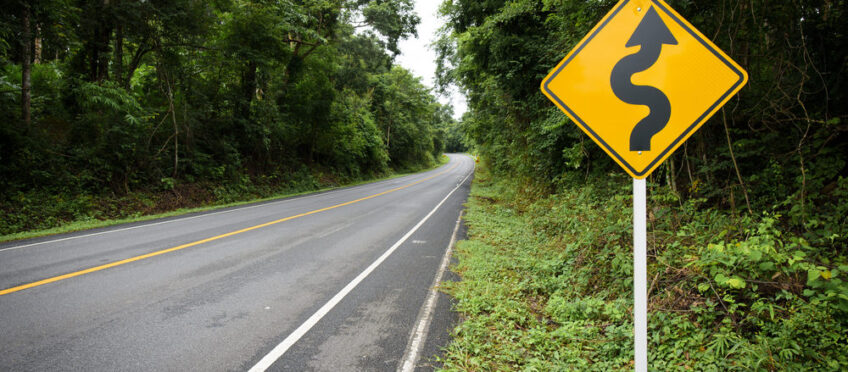Ahhhh, spring riding! After a winter of hibernation, the first rides of spring are some of the most exhilarating of the year. Spring also ushers in unique seasonal risks calling for extra vigilance to stay safe on the road.
Knowing what to expect and how to manage them mitigates the risks.
11 Spring Motorcycle Hazards to Prepare For
- Potholes. Over the winter, water in the underlying soil freezes and expands, lifting the asphalt. Traffic fatigues the raised surface and snow plow blades skim it off, leaving behind a gaping hole and crumbling road edges. If potholes are wide and deep enough, like many on our roads, hitting them can damage your wheel rim and make you lose control. The only way to deal with them is to remain attentive and avoid them, and hope the road crews get out soon.If you cannot avoid the pothole, scrub off speed if possible before you reach it, then keep your speed constant. Keep your eyes focused on where you want to go, your front wheel straight, and a relaxed grip on the handlebars. As you near the pothole, stand up slightly so your legs act as shock absorbers, keeping your weight to the rear of the motorcycle. Avoid the brakes. Once through the pothole, resume your speed and your normal riding position, smoothly. Remain alert, follow at a safe distance, and avoid the next one!
- Road Debris. Anything that’s on the road gets scraped up by snow plows and left behind when the snow melts. Even what’s scraped onto the shoulder can end up on the road. Be alert for plastic bottles, trash, and toys.
- Road salt and sand. They’re necessary to keep the roads safe during our winters, but they create hazards for motorcyclists. Salt leaves a fine film, which reduces traction. It’s also very corrosive and gets in every crevice of your bike.Sand accumulates in corners, intersections, and between tire tracks. Residue is more prevalent on low-traffic roads, but prepare for it on all streets, especially in turns. You don’t want to see it when you’re leaned over in a corner. Better yet, wait for a heavy rainfall or street sweepers to clean the road before heading out.
- Black Ice. Even the smoothest pavement has surface texturing. Moisture can settle in those tiny indentations, even when the road surface appears dry. When temperatures drop, as they do during the variableness of spring, the water freezes, expands, and creates an invisible sheet of ice. Black ice can also form when it’s raining and the road surface temperature is around freezing, or melting snow freezes as the temperature drops. Use extra caution any time your temperature gauge is 3°C or lower.
- Rusty Skills. It doesn’t matter how long you’ve been riding or how fantastic a rider you think you are. Skills rust when they’re not used. Make a parking lot your first spring destination and practice slow speed maneuvers, quick braking, and swerves. Develop the muscle memory to make your reactions automatic and controlled. The likelihood of having to use them is high. Practice so they’re there when you need them. Even if it’s once or twice, it’s worth it. Read: How to Make Sure You’re Ready to Ride.
- Car Drivers and Other Traffic. They haven’t had to share the road with you for at least four months. Drivers don’t see you at the best of times, let alone when they’re not expecting you. Give yourself plenty of space, pay attention to what other drivers are doing, anticipate their next move, and make yourself as visible as possible. Assume you’re invisible.
- Small mammals, like raccoons, possums, skunks, and other rodents are more active in spring. As they leave their winter nests and begin showing their young how to forage and fend for themselves, they emerge onto roads. Exercise extra vigilance at dawn and dusk.
- Suboptimal Physical Fitness. Being fit helps you better manage your motorcycle while riding and moving it in your garage. It gives you more stamina to enjoy the ride, flexibility to react to change, and strengthens your bones to better withstand the unexpected. Read: How to Get Fit for Riding Season.
- Motorcycle Readiness. Even if you were meticulous in winterizing your bike, give it a thorough going over before taking it out that first time. It’s carrying precious cargo! Tires will likely have lost air pressure and need a top up. Check cables, fluid levels, and tire treads. Look for signs of leaks or loose parts. Read: Get Your Motorcycle Ready for Spring.
- Early spring brings unpredictable weather with quick temperature drops. Layer your gear and dress for weather that’s colder than it is. You can always remove a layer. Be prepared for rain.Hypothermia can occur at any time of year and be insidious. Cold hands and feet are an early sign it’s time to warm up. Physical and mental fatigue reduces your reaction time, impairs your judgement, and reduces your endurance. Stay warm and dry.
- Other motorcycle riders. Everyone emerges from hibernation in spring. Not all riders will be as prepared, aware, and alert as you are. Exercise greater caution when riding with a group – i.e. any more than one person.
Make an annual skills refresher course under the guidance of experienced instructors, a rite of spring. A skills refresher or advanced riding course delivered by recognized schools can refresh your skills. Off-road courses are great for teaching you how to deal with the unexpected on the road. Track days are also great for teaching you new skills. Do something! It can save your life. And it’s fun!









join the conversation